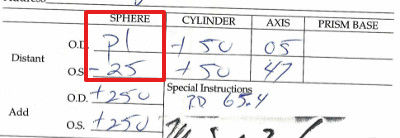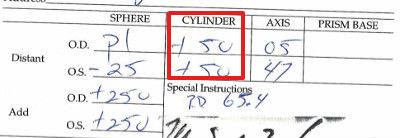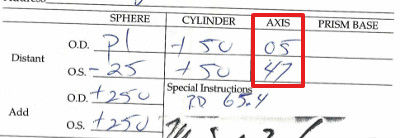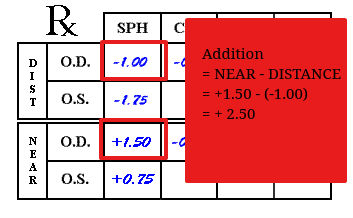1. O.D./O.S.
What you’ll notice first in your prescription are the abbreviations of Oculus Dexter and Oculus Sinister. These are the Latin terms for right eye and left eye respectively.
Some prescriptions might even have an additional column labeled O.U. which stands for Oculus Uterque. O.U. refers to both eyes.
Abbreviated Latin terms are traditionally used in prescriptions for eyeglasses. However nowadays some doctors may use RE (right eye) or LE (left eye) instead of the Latin O.D. and O.S.
Interesting to know is that O.D. values appear before O.S. values on your prescription. Since your right eye is the first eye that your doctor checks because it is to his left, hence he notes down the right eye value first and then subsequently the left eye readings.
2. SPH

The Above Sphere is:
Right: -0.50
Left: -1.25

The Above Sphere is:
Right: Plano
Left: -0.25
This abbreviation indicates whether the patient is nearsighted or farsighted. Sphere refers to the amount of lens power prescribed to correct the diagnosed myopic or hyperopic condition.
Negative numbering indicates nearsightedness while positive values are indicative of shortsightedness. The further a value is from zero, the more the patient’s vision has deteriorated.
The spherical values on your prescription are measured in diopters (D).
3. CYL

The Above Cylinder is:
Right: -0.25
Left: -0.50

The Above Cylinder is:
Right: +0.50
Left: +0.50
The abbreviated term for Cylinder, CYL refers to the lens power reading for astigmatism. In the case that this column is left blank it would mean that the patient has no astigmatism, slight or is so small a value that it is not necessary to correct. Cylinder power always follows Sphere power in a prescription.
If the reading in the cylinder column is preceded with a negative connotation then it signifies a correction for nearsighted astigmatism and a positive preceded value is indicative of a correction for farsighted astigmatism.





